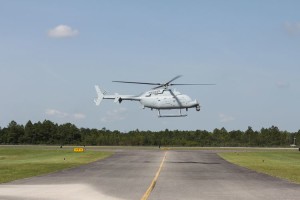The first East Coast Squadron to operate the MQ-8C Fire Scout unmanned helicopter received its initial aircraft this month, the Navy said Sept. 18.
Helicopter Sea Combat Squadron (HSC) 22 received its first MQ-8C on Sept. 15 while at Naval Station Norfolk, Va.

The Fire Scout is built by Northrop Grumman [NOC] using the Bell [TXT] 407 airframe. It is a larger and longer endurance variant of the MQ-8B vehicle and can operate for up to 12 hours on station, depending on the payload.
The Navy intends to deploy the MQ-8C with Littoral Combat Ships (LCSs) for reconnaissance, situational awareness, and precision targeting support, complementing the manned MH-60. It also intends to use the aircraft for surface warfare and mine countermeasures payloads for MCSs and other aviation-capable ships.
The service said now NSC-22 is the first East Coast Squadron to operate the MQ-8C, MQ-8B, and MH-60S Knighthawk helicopters.
“Incorporating the MQ-8C will represent a significant improvement in our unmanned air vehicle mission capability. The ‘Charlie’ is bigger, faster, can carry more mission equipment, and remain airborne over twice as long as our already-proven MQ-8B’s,” Cmdr. Matthew Wright, HSC-22’s commanding officer, said in a statement.
HSC-22 is tasked providing manned and unmanned maritime attack and combat support capabilities to the fleet.
Testing of the MQ-8C first began in 2017 aboard the USS Montgomery (LCS-8) and the aircraft subsequently first reached initial operational capability last year (Defense Daily, July 8, 2019).
The Navy has procured 38 MQ-8Cs with no further planned procurement.
However, in February, the Defense Department’s top weapons tester said the 8C model was not operationally effective, suitable or cyber survivable. It named the primary degraders as overall air vehicle reliability, image quality and system performance of the AN/AAQ-22D BRITE Star II multi-sensor imaging system, and poor reliability and inconsistency of the Tactical Common Data Link (Defense Daily, Feb. 5).
That same report revealed the Navy’s program office established a “Tiger Team” to increase readiness and reliability of the aircraft’s systems.
In February, Naval Air Systems Command said it planned to study with Northrop Grumman what weapons could be placed on the MQ-8C, helping to determine potential upgrades and reduce weaponization risks (Defense Daily, Feb. 14).
The aircraft is scheduled to deploy with LCS’s starting in fiscal year 2021.